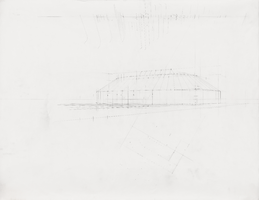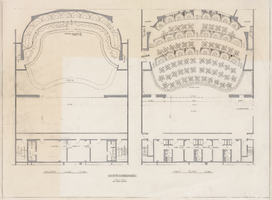Search the Special Collections and Archives Portal
Search Results

Architectural drawing of Thunderbird Hotel (Las Vegas), 214 room addition, exterior elevations, October 23, 1962
Date
Archival Collection
Description
Architectural plans for the addition of the Aztec Building to the Thunderbird Hotel.
Site Name: Thunderbird Hotel
Address: 2755 Las Vegas Boulevard South
Image

Sketch of Circus Circus (Las Vegas), main building, circa 1967
Date
Archival Collection
Description
Skeletal sketch of the main building of Circus Circus; drawn with pencil on paper
Site Name: Circus Circus Las Vegas
Address: 2880 Las Vegas Boulevard South
Image

Sketch of Circus Circus (Las Vegas), site plan, December 6, 1967
Date
Archival Collection
Description
Rough sketch of the site plan of Circus Circus noted "For Sarno Approval;" mixed media on tissue paper
Site Name: Circus Circus Las Vegas
Address: 2880 Las Vegas Boulevard South
Image

Architectural drawing of Circus Circus (Las Vegas), Hippodrome, circa 1968
Date
Archival Collection
Description
First floor and balcony floor plans for the Circus Circus Hippodrome. Printed on parchment.
Site Name: Circus Circus Las Vegas
Address: 2880 Las Vegas Boulevard South
Image

Architectural drawing of the Western Village theme park (Las Vegas), grocery and general stores, exterior elevations, 1947
Date
Archival Collection
Description
Architectural plan for a component of the Western Village (ultimately named Last Frontier Village) at the Hotel Last Frontier from 1947.
Site Name: Frontier
Address: 3120 Las Vegas Boulevard South
Image

Photograph of Sahara Tower under construction (Las Vegas), February 30, 1971
Date
Archival Collection
Description
View of the construction of a tower at the Sahara. Stamped on original: "Las Vegas News Bureau. Las Vegas - Nevada. Photographers: Don English. Jerry Abbott. Joe Buck. Milt Palmer. John Cook."'
Site Name: Sahara Hotel and Casino
Address: 2535 Las Vegas Boulevard South
Image

Photograph of Circus Circus exterior shortly after opening (Las Vegas), 1968
Date
Archival Collection
Description
View of the Circus Circus Casino shortly after opening. Paper residue left on photo. Stamped on original: "Please credit Las Vegas News Bureau"'
Site Name: Circus Circus Las Vegas
Address: Las Vegas; Clark County; Nevada
Image

Aerial photograph of Circus Circus after the addition of a second tower, 1986
Date
Archival Collection
Description
Circus Circus after the addition of the second tower. Paper residue left on photo. Stamped on original: "Please credit Las Vegas News Bureau"
Site Name: Circus Circus Las Vegas
Address: 2880 Las Vegas Boulevard South
Image

Photograph of the Flamingo Hilton after the completion of its sixth tower (Las Vegas), 1980s
Date
Archival Collection
Description
The Flamingo Hilton after the completion of the sixth tower.
Site Name: Flamingo Hotel and Casino
Address: 3555 Las Vegas Boulevard South
Image

Photograph of the Flamingo Hotel complex (Las Vegas), circa 1980s
Date
Archival Collection
Description
View of the Flamingo Hotel complex in the 1980s. Stamped on original: "Please credit Las Vegas News Bureau. 62126. Photographers: Don English, Jerry Abbott, Milt Palmer, Wolf Wergin, Gary Angell, Tony King, John Litty, Cliff Stanley, Don Knepp."
Site Name: Flamingo Hotel and Casino
Address: 3555 Las Vegas Boulevard South
Image
